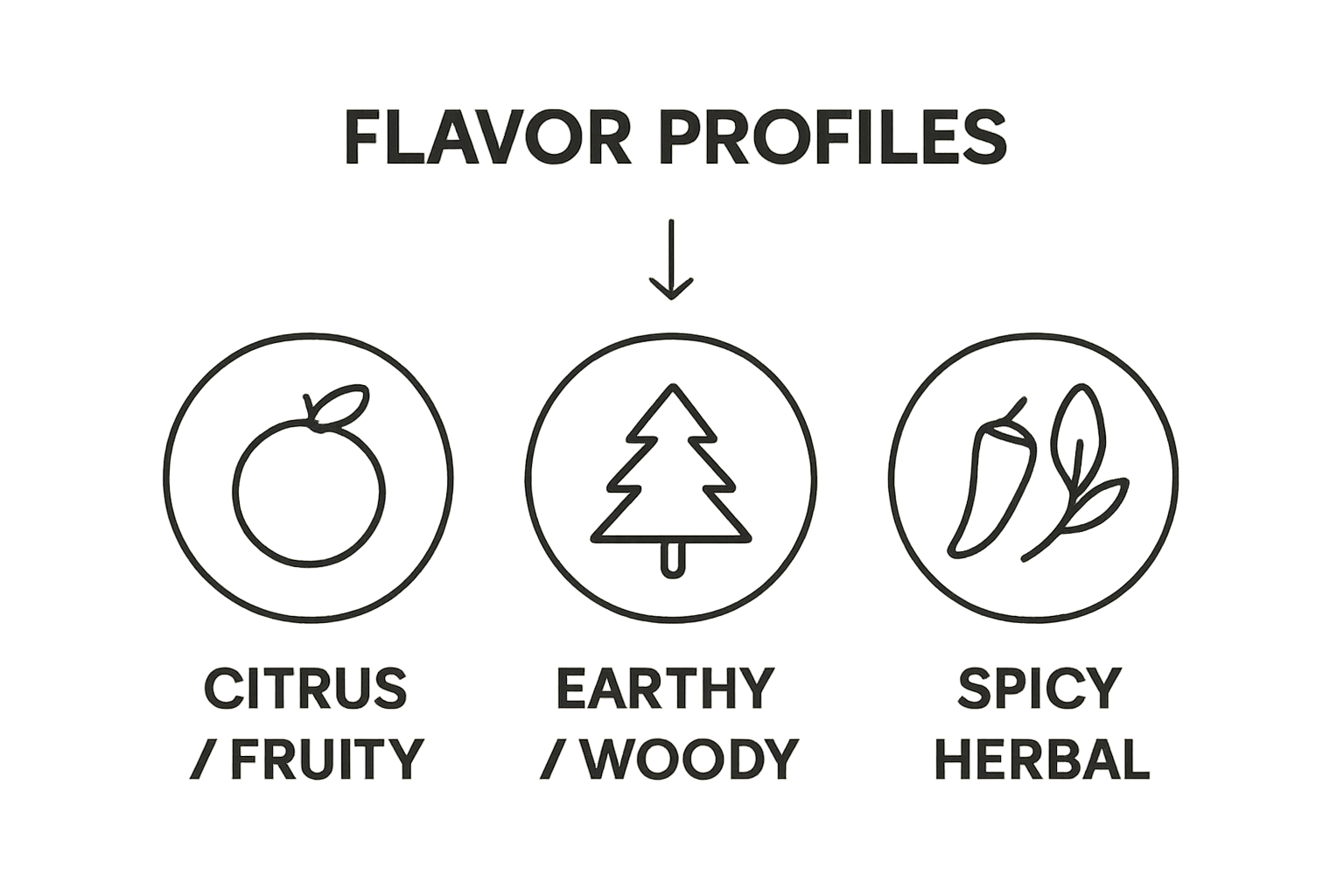Blog
Understanding Flavor Profiles in Cannabis
Cannabis strains each carry a unique flavor profile, shaping not just how they taste but also how they feel. Some people expect weed to just taste earthy, but that’s only part of the story. Scientists have found over 200 different terpenes in cannabis, each adding its own twist to every puff. This means your favorite strain’s flavor might offer more clues about its effects than you ever realized.
Table of Contents
- What Are Flavor Profiles In Cannabis?
- The Importance Of Flavor Profiles For Consumers
- How Terpenes Influence Cannabis Flavor
- Exploring Common Flavor Profiles In Cannabis Strains
- Flavor Profiles As Indicators Of Quality And Effects
Quick Summary
| Takeaway | Explanation |
|---|---|
| Flavor profiles define cannabis experience. | Cannabis flavor profiles are complex sensory characteristics formed by chemical compounds that influence taste and aroma. |
| Terpenes shape flavors and effects. | Terpenes are key organic compounds that create unique flavors and may affect the physiological and psychological responses to cannabis. |
| Understand flavor for informed strain selection. | Consumers can predict potential effects based on flavor profiles, aiding in the selection of strains for relaxation, energy, or creativity. |
| Flavor profiles indicate product quality. | Flavor characteristics serve as molecular fingerprints, revealing genetic quality and effective therapeutic potential of cannabis strains. |
| Explore diverse flavors for enhanced enjoyment. | Each cannabis strain’s flavor offers a unique sensory journey, appealing to both recreational and medicinal consumers seeking specific experiences. |
What are Flavor Profiles in Cannabis?
Flavor profiles in cannabis represent the complex sensory characteristics that define a particular strain’s unique taste and aroma experience. These intricate combinations emerge from a sophisticated interaction between various chemical compounds, primarily terpenes and flavonoids, which give each cannabis variety its distinctive sensory signature.
The Chemical Composition of Cannabis Flavors
At the core of cannabis flavor profiles are terpenes, organic compounds responsible for producing the plant’s aromatic qualities. According to research published in the National Institutes of Health, these microscopic molecules create the nuanced flavor spectrum ranging from earthy and pine-like to citrusy and sweet. Key terpenes such as myrcene, limonene, and pinene contribute distinctively to the overall sensory experience, much like how different herbs and spices create unique culinary profiles.
The flavor complexity extends beyond just taste and smell. Terpenes interact synergistically with cannabinoids in what scientists call the “entourage effect,” potentially influencing the overall cannabis experience. This means the flavor profile isn’t just about sensory pleasure but might also impact the physiological and psychological effects of consumption.
Understanding Flavor Complexity
Cannabis flavor profiles can be categorized into several broad families, each offering a unique sensory journey. Some primary flavor categories include:

- Earthy/Woody: Characterized by deep, forest-like undertones
- Citrus/Fruity: Bright, tangy flavor notes reminiscent of lemon or berries
- Spicy/Herbal: Complex profiles with peppery or botanical characteristics
Consumers interested in exploring more about these fascinating flavor variations might want to read our comprehensive guide on flavor-specific strains to deepen their understanding of this intricate sensory landscape.
The Importance of Flavor Profiles for Consumers
Flavor profiles play a pivotal role in the cannabis consumer experience, transforming product selection from a mere transactional choice to a nuanced sensory journey. For modern cannabis enthusiasts, understanding flavor profiles represents far more than aesthetic appreciation—it’s about selecting products that align with personal preferences and desired experiences.
Personal Preference and Experience Selection
Consumers leverage flavor profiles as a sophisticated method of predicting potential effects and enjoyment. Research from the National Institutes of Health indicates that flavor and aroma are critical factors in strain selection, with users reporting that specific flavor characteristics correlate with anticipated physiological and psychological responses.
The sensory experience becomes a critical decision-making tool. Different flavor profiles can signal potential outcomes, helping consumers choose strains that might promote relaxation, creativity, or energy. For instance, citrusy strains might suggest an uplifting experience, while earthy profiles could indicate more sedative potential.
Therapeutic and Recreational Considerations
Beyond personal enjoyment, flavor profiles carry significant implications for both medicinal and recreational cannabis consumers. The intricate chemical interactions between terpenes and cannabinoids mean that flavor isn’t just about taste—it’s about potential therapeutic benefits.
Key considerations for consumers include:
- Medicinal Users: Specific flavor profiles might indicate potential relief for conditions like anxiety, pain, or sleep disorders
- Recreational Consumers: Flavor becomes a gateway to predicting and curating desired mental and physical experiences
- Sensory Enthusiasts: Exploring diverse flavor profiles represents an intellectual and gustatory adventure
For those interested in diving deeper into the world of cannabis flavors, our comprehensive guide on the role of flavor in vaping offers additional insights into this fascinating sensory landscape.
How Terpenes Influence Cannabis Flavor
Terpenes serve as the primary architects of cannabis flavor, creating a complex sensory landscape that goes far beyond simple taste and aroma. These microscopic organic compounds are responsible for generating the nuanced flavor profiles that make each cannabis strain unique, functioning as nature’s flavor designers.
The Chemical Mechanism of Flavor Generation
At the molecular level, terpenes create distinctive flavor experiences through their intricate chemical structures. According to scientific research published in the National Institutes of Health, these compounds interact dynamically with cannabinoids, producing what experts call the “entourage effect”—a sophisticated interaction that transforms sensory perception.
Each terpene contributes a specific flavor note, much like musical instruments in an orchestra. Some terpenes produce sharp, citrusy notes, while others generate deep, earthy undertones. The concentration and combination of these compounds determine the final flavor profile, creating an extraordinarily complex sensory experience.
The following table summarizes the primary terpenes found in cannabis, their flavor signatures, and typical effects associated with each, helping readers quickly compare their unique contributions.
| Terpene | Flavor Signature | Typical Associated Effects |
|---|---|---|
| Myrcene | Earthy, musky, clove-like | Relaxation, sedation |
| Limonene | Citrus, lemon, orange | Uplifting, energetic |
| Pinene | Pine, fresh forest | Mental clarity, alertness |
| Caryophyllene | Spicy, peppery, woody | Stress relief, mild relaxation |
Primary Terpenes and Their Flavor Signatures
Different terpenes generate remarkably distinct flavor experiences. Understanding these variations helps consumers appreciate the intricate world of cannabis flavors:
- Myrcene: Produces earthy, musky flavors reminiscent of herbs and cloves
- Limonene: Generates bright, citrusy notes similar to lemon and orange peels
- Pinene: Creates pine-like, fresh forest flavors with crisp undertones
- Caryophyllene: Delivers spicy, peppery flavor profiles with woody characteristics
For enthusiasts eager to explore these fascinating flavor nuances in more depth, our comprehensive guide to terpene types offers detailed insights into the molecular magic behind cannabis aromas.
Exploring Common Flavor Profiles in Cannabis Strains
Cannabis flavor profiles represent a rich tapestry of sensory experiences, each strain offering a unique combination of taste, aroma, and subtle nuances that distinguish it from others. These complex flavor landscapes emerge from intricate chemical interactions between terpenes, cannabinoids, and other plant compounds.
Citrus and Fruity Flavor Profiles
Research published in Frontiers in Plant Science highlights the prominence of citrus and fruity flavor profiles in cannabis strains. Strains with high limonene content deliver bright, zesty flavor experiences reminiscent of lemon, orange, and other citrus fruits. These profiles are often associated with uplifting and energetic effects, making them popular among consumers seeking a refreshing and invigorating cannabis experience.

Citrus-forward strains typically feature sharp, clean flavor notes that cut through more traditional earthy cannabis tastes. The intense aromatic qualities can range from subtle tangerine undertones to bold, mouth-puckering lemon sensations, providing a dynamic sensory journey for enthusiasts.
Earthy and Herbal Flavor Territories
Earthy and herbal flavor profiles represent the traditional, more grounded side of cannabis sensory experiences. Dominated by terpenes like myrcene and pinene, these strains deliver complex flavor notes that evoke images of dense forests, rich soil, and wild botanical landscapes.
Key characteristics of earthy and herbal flavor profiles include:
- Deep, Complex Undertones: Reminiscent of damp forest floors and fresh vegetation
- Woody Nuances: Hints of pine, cedar, and other forest-derived aromatics
- Musky Characteristics: Subtle hints of clove, herbs, and aged botanical elements
For cannabis enthusiasts interested in diving deeper into the intricate world of flavor exploration, our guide to understanding flavor-specific strains offers comprehensive insights into this fascinating sensory landscape.
Flavor Profiles as Indicators of Quality and Effects
Flavor profiles represent far more than just a sensory experience in cannabis—they are sophisticated chemical signatures that offer profound insights into product quality, potential effects, and overall therapeutic potential. These intricate aromatic landscapes serve as complex biochemical indicators that discerning consumers and medical professionals can decode.
This table categorizes common cannabis flavor profiles, highlights their characteristic notes, and lists the typical experiences or effects associated with each profile for easy reference.
| Flavor Profile | Characteristic Flavor Notes | Typical Associated Experience |
|---|---|---|
| Earthy/Woody | Deep, forest-like, musky, woody | Sedative, relaxing |
| Citrus/Fruity | Bright, tangy, lemon, orange, berry | Uplifting, energetic |
| Spicy/Herbal | Peppery, botanical, clove, herbal | Stimulating, creativity, alertness |
Molecular Markers of Cannabis Quality
Research exploring cannabis secondary metabolites reveals that flavor profiles function as molecular fingerprints, providing critical information about a strain’s genetic composition, cultivation conditions, and potential pharmacological characteristics. The combination and concentration of terpenes within a strain can signal important quality metrics that go well beyond surface-level sensory appreciation.
Quality indicators embedded within flavor profiles include precise measurements of terpene diversity, cannabinoid ratios, and the overall chemical complexity of the plant. Experienced consumers and medical professionals can distinguish between high-quality and lower-grade cannabis by carefully analyzing these nuanced flavor characteristics.
Predicting Potential Physiological Effects
Terpenes do not merely contribute to flavor—they actively participate in modulating the cannabis experience through what scientists call the “entourage effect.” This sophisticated interaction between terpenes and cannabinoids suggests that specific flavor profiles can provide predictive insights into potential physiological and psychological outcomes.
Key predictive flavor profile characteristics include:
- Citrus-Based Profiles: Often associated with energetic, mood-elevating experiences
- Earthy, Musky Profiles: Typically linked to relaxation and potential sedative effects
- Pine-Forward Profiles: May contribute to enhanced focus and mental clarity
For cannabis enthusiasts seeking to understand the intricate relationship between flavor and experience, our comprehensive guide to understanding terpene types offers deeper insights into this fascinating biochemical landscape.
Discover Cannabis Products Tailored to Your Favorite Flavor Profiles
Are you searching for premium cannabis products that truly match your personal flavor preferences? After learning how terpenes and flavor profiles shape your experience, you deserve options that are not only flavorful but also trustworthy. Many people struggle to find high-quality vapes, pre-rolls, and edibles that actually deliver the full spectrum of effects promised by different flavor profiles. If you value purity, authenticity, and nuanced flavor experiences, settling for questionable products just is not worth the risk.
.png)
Explore Puff Laco today and enjoy expertly crafted products tested for purity, authenticity, and rich terpene profiles. Our flavor-specific strains and full spectrum extracts ensure a sensory journey that matches your needs for both recreation and wellness. Visit Puff Laco now to unlock exclusive discounts and experience the difference of science-backed, reliably delicious cannabis products. Trust your senses. Upgrade your cannabis routine with Puff Laco’s collection today.
Frequently Asked Questions
What are flavor profiles in cannabis?
Flavor profiles in cannabis refer to the unique combinations of taste and aroma that define a strain, primarily influenced by terpenes and flavonoids. These profiles create distinct sensory experiences for consumers.
How do terpenes affect cannabis flavor?
Terpenes are organic compounds that produce the aromatic qualities of cannabis. They interact with cannabinoids to create complex flavor profiles, contributing to the overall experience of each strain.
Why are flavor profiles important to cannabis consumers?
Flavor profiles help consumers make informed decisions by predicting potential effects and enjoyment. They allow users to select strains based on personal preferences, enhancing the overall cannabis experience.
How can flavor profiles indicate the quality of cannabis?
Flavor profiles serve as molecular fingerprints that can reveal important details about a strain’s genetic makeup, cultivation conditions, and potential therapeutic qualities, helping consumers assess product quality effectively.
Recommended
- Understanding What Are Flavor-Specific Strains – PUFF LA
- Understanding the Role of Flavor in Vaping Experience – PUFF LA
- 7 Terpene Types Explained: Unlocking Cannabis Aromas – PUFF LA
- Understanding the Role of Strain Selection in Cannabis – PUFF LA

